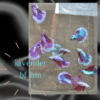The Standard for Long Fin Spade Tail
Introduction
Betta fish, with their vibrant colors and elaborate fin structures, have long been a favorite among aquarists. Among these, the Long Fin Spade Tail betta is a relatively recent addition to the show arena. Despite its newness, it has already garnered significant interest due to its distinct characteristics and potential for further development. This article will delve into the specific standards that define the Long Fin Spade Tail betta, focusing on its caudal fin symmetry, size requirements, and the prospects for this variant in future competitions.

Understanding the Long Fin Spade Tail Betta
The Unique Asymmetry
The Long Fin Spade Tail betta is distinguished by its asymmetrical caudal fin, which sets it apart from other show bettas. Unlike the veiltail, which has a more flowing and less structured fin, the Long Fin Spade Tail’s caudal fin requires a precise mid-line symmetry. This symmetry means that the top and bottom parts of the fin should mirror each other perfectly, creating a balanced and aesthetically pleasing appearance. The precise nature of this symmetry is what makes the Long Fin Spade Tail both challenging and rewarding for breeders aiming for show-quality specimens.
Caudal Fin Size and Proportions
One of the most critical aspects of the Long Fin Spade Tail’s standard is the size of its caudal fin. The minimum size requirement for the caudal fin is half of the body length. However, the ideal proportion is a 1:1 ratio, meaning the caudal fin should be equal in length to the body of the fish. This balance ensures that the fish displays the full elegance of its fin without appearing disproportionate or ungainly. Achieving this ideal size requires careful breeding and selection, emphasizing the importance of genetic quality and meticulous care in developing show bettas.
Color and Pattern Variations
While the primary focus for the Long Fin Spade Tail betta is on its fin structure and proportions, color and pattern also play a significant role in its overall appeal. These bettas can come in a wide array of colors and patterns, each adding to the visual impact of the fish. Judges often look for vibrant, even coloration and distinct patterns that complement the fish’s fin structure. Solid colors, marbles, and even bi-colors can all be found within this variant, providing a rich palette for breeders to work with.
Breeding Challenges and Considerations
Genetic Consistency
Breeding Long Fin Spade Tail bettas to meet the stringent standards required for show competition is no small feat. Genetic consistency is a primary challenge, as breeders must ensure that each generation maintains the desired caudal fin symmetry and size. This often involves selective breeding practices, where only the best specimens are chosen for reproduction. Additionally, breeders must be vigilant about avoiding genetic defects and health issues that can arise from inbreeding or poor genetic diversity.
Care and Maintenance
Proper care and maintenance are crucial for developing high-quality Long Fin Spade Tail bettas. These fish require clean, well-maintained environments to thrive and display their full potential. Regular water changes, appropriate tank conditions, and a balanced diet are all essential components of their care. Moreover, breeders must be attentive to the specific needs of Long Fin Spade Tails, particularly regarding their fins, which can be prone to damage and disease if not properly cared for.
Future Prospects for Long Fin Spade Tail Bettas
Emerging Trends in Show Competitions
While no modern variant of the Long Fin Spade Tail has dominated the show betta arena yet, the potential for this variant is undeniable. As breeders continue to refine and perfect their stock, it is likely that we will see more Long Fin Spade Tails making their mark in competitions. The unique characteristics of this variant offer a fresh and exciting challenge for breeders and judges alike, promising to add new dimensions to the world of show bettas.
Innovations in Breeding Techniques
Advancements in breeding techniques and a deeper understanding of betta genetics are likely to play a significant role in the development of the Long Fin Spade Tail variant. Breeders are continually experimenting with new methods to achieve the perfect caudal fin symmetry and size. This includes cross-breeding with other betta types, refining selection criteria, and improving care practices. Such innovations will help establish the Long Fin Spade Tail as a prominent and respected category in show betta competitions.
Detailed Criteria for Long Fin Spade Tail Betta
Caudal Fin Symmetry
The hallmark of the Long Fin Spade Tail betta is its caudal fin symmetry. The fin should have a clear mid-line that divides the top and bottom parts into mirrored images. This symmetry is essential for the fish to qualify as a Long Fin Spade Tail in competitions. Judges look for a perfect balance between the two halves, with no discrepancies in shape or size.
Caudal Fin Size
As previously mentioned, the caudal fin should be at least half the length of the body. Ideally, the fin should match the body length, achieving a 1:1 ratio. This proportion is crucial for the fish’s overall appearance, providing a sense of harmony and elegance.
Pointed Tips on Unpaired Fins
For a Long Fin Spade Tail betta to meet the show standards, all unpaired fins must have respective pointed tips. This includes the dorsal, anal, and caudal fins. The pointed tips enhance the fish’s streamlined appearance, contributing to its overall aesthetic appeal.
Primary and Secondary Rays
The fins of the Long Fin Spade Tail betta should display well-defined primary rays on the dorsal and anal fins, as well as secondary rays on the caudal fin. These rays are integral to the structure and strength of the fins, ensuring they maintain their shape and symmetry.
Ventral Fin Length
The ventral fins of the Long Fin Spade Tail betta should be equal in length to the anal fin. This uniformity adds to the fish’s balanced appearance, creating a cohesive look that judges seek in show-quality specimens.
Caudal Spread
The caudal fin should spread at a full 180 degrees, forming a broad and striking display. This spread showcases the fin’s symmetry and size, highlighting the fish’s unique characteristics.
The Path to Perfection
Breeding Programs
To achieve the perfect Long Fin Spade Tail betta, breeders must implement rigorous breeding programs. This involves selecting only the finest specimens with the desired traits and continuously refining the gene pool. Patience and dedication are essential, as it can take several generations to produce fish that meet the strict standards of show competitions.
Health and Nutrition
Maintaining the health and vitality of Long Fin Spade Tail bettas is crucial for their development. A balanced diet, regular health checks, and optimal tank conditions are all necessary to ensure these fish thrive. Breeders must be vigilant about preventing diseases and providing the best possible care to their stock.
Show Preparation
Preparing a Long Fin Spade Tail betta for a show requires meticulous attention to detail. This includes conditioning the fish, ensuring their fins are in perfect condition, and acclimating them to the show environment. Breeders often use specialized tanks and feeding regimens to bring out the best in their fish, enhancing their chances of success in competitions.
Conclusion
The Long Fin Spade Tail betta is a captivating and unique addition to the world of show bettas. Its distinctive caudal fin symmetry, size requirements, and overall aesthetic appeal make it a challenging yet rewarding variant for breeders and enthusiasts. As the standards for this variant continue to evolve, it is likely that the Long Fin Spade Tail will gain greater recognition and prominence in show competitions. With dedication, innovation, and a deep understanding of betta genetics, breeders can achieve the perfect Long Fin Spade Tail betta, setting new benchmarks in the world of aquatics.
FAQs
What makes the Long Fin Spade Tail betta different from other betta types?
The Long Fin Spade Tail betta is characterized by its asymmetrical caudal fin with precise mid-line symmetry, unlike other types such as the veiltail. This unique fin structure requires meticulous breeding and selection to achieve the desired appearance.
What are the size requirements for the caudal fin of a Long Fin Spade Tail betta?
The caudal fin should be at least half the length of the body, with the ideal proportion being a 1:1 ratio, meaning the fin is equal in length to the body.
How do breeders ensure the symmetry of the caudal fin in Long Fin Spade Tail bettas?
Breeders achieve caudal fin symmetry through selective breeding practices, choosing only the best specimens with the desired traits for reproduction. This process involves several generations of careful breeding and selection.
Why are pointed tips on unpaired fins important for Long Fin Spade Tail bettas?
Pointed tips on unpaired fins, including the dorsal, anal, and caudal fins, enhance the fish’s streamlined appearance and contribute to its overall aesthetic appeal. These tips are a key criterion in show competitions.
What care practices are essential for maintaining high-quality Long Fin Spade Tail bettas?
Proper care includes clean, well-maintained tank environments, regular water changes, and a balanced diet. Additionally, breeders must be attentive to the specific needs of Long Fin Spade Tails, particularly regarding their fins, which can be prone to damage and disease.
What future prospects exist for the Long Fin Spade Tail betta in show competitions?
As breeders continue to refine and perfect their stock, the Long Fin Spade Tail betta is likely to gain greater recognition and prominence in show competitions. Innovations in breeding techniques and a deeper understanding of betta genetics will play a significant role in this development.






